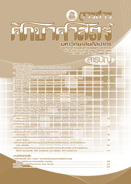การประเมินหลักสูตรปรัชญาดุษฎีบัณฑิต สาขาวิชาพัฒนศึกษา คณะศึกษาศาสตร์ มหาวิทยาลัยศิลปากร
Main Article Content
Abstract
ผลการวิจัยพบว่า
1. การประเมินสภาพแวดล้อม/บริบท ด้านวัตถุประสงค์ พบว่าผู้ประเมินทุกกลุ่มมีความเห็นสอดคล้องกันว่าวัตถุประสงค์ของหลักสูตรทั้ง 5 ข้อมีความชัดเจน เหมาะสมกับสภาพการณ์ในปัจจุบัน มีความสอดคล้องกับนโยบายของหน่วยงานต่างๆ และมีความสอดคล้องกับความต้องการของผู้เรียนในระดับมากถึงมากที่สุด ( = 4.45 - 5.00) ด้านโครงสร้างของหลักสูตรพบว่ามีความเหมาะสมในระดับมากถึงมากที่สุด (
= 4.46 - 4.89) ด้านความเหมาะสมของรายวิชาพบว่ามีความเหมาะสมอยู่ในระดับมากที่สุด (
= 4.56 - 4.92)
2. การประเมินปัจจัยนำเข้า ด้านปัจจัยสนับสนุนของหลักสูตร ได้แก่ ทรัพยากรที่ใช้ในการดำเนินการ สื่อตำรา และสถานที่ มีความเหมาะสมในระดับมากถึงมากที่สุด ( = 3.92 - 4.88) ด้านสิ่งที่เกี่ยวข้องในหลักสูตร ได้แก่ คุณลักษณะผู้สอนพบว่ามีความเหมาะสมอยู่ในระดับมากถึงมากที่สุด (
= 4.45 - 5.00) คุณลักษณะของผู้เรียนและการบริหารจัดการหลักสูตรพบว่ามีความเหมาะสมอยู่ในระดับมากที่สุด (
= 4.83 - 5.00)
3. การประเมินกระบวนการ ประกอบไปด้วย 2 ด้าน ได้แก่ ด้านกิจกรรมการเรียนการสอน พบว่ามีความเหมาะสมในระดับมากถึงมากที่สุด ( = 4.38 - 5.00) ด้านการวัดและประเมินผลพบว่ามีความเหมาะสมในระดับมากถึงมากที่สุด (
= 4.40 - 5.00)
4. การประเมินผลผลิตระหว่างทางของหลักสูตร คณะกรรมการบริหารหลักสูตร และอาจารย์ผู้สอนมีความคิดเห็นเกี่ยวกับผลผลิตของหลักสูตรปรัชญาดุษฎีบัณฑิต สาขาวิชาพัฒนศึกษาสอดคล้องกัน โดยเห็นว่ามีความเหมาะสมในระดับมากที่สุด ( = 4.72 - 4.83)
5. การศึกษาสภาพปัญหา อุปสรรค ความต้องการและข้อเสนอแนะของผู้ที่เกี่ยวข้องที่มีต่อการบริหารจัดการหลักสูตร พบว่าควรเพิ่มเติมรายวิชาทางอนาคตศึกษา เพื่อเตรียมความพร้อมในการเข้าสู่ประชาคมเศรษฐกิจอาเซียน
Curriculum Evaluation of Doctor of Philosophy in Development Education, Faculty of Education, Silpakorn University
The objectives of the Curriculum Evaluation of Doctor of Philosophy in Development Education, Faculty of Education, Silpakorn University are to evaluate the progress of the operation in environment/context, inputs, graduate production process, intermediate outcomes/effect of the program, and to study the problems, obstacles, needs, and suggestions of the person involved about the program administration. This research has 4 groups of data provider, which are 1) Program committee 2) Experts 3) Current students 4) Teachers. The evaluation of this program is a formative evaluation, which collects both quantitative and qualitative data. Tools used in this research are questionnaires and interview guidelines. Quantitative data analysis uses frequency distribution statistic, percent (%), mean ( ), and standard deviations (SD), while qualitative data analysis use content analysis and conclude the main points from the interviews, then report in essay.
Research result showed that:
1. Environment/context evaluation about objectives finds that all evaluators have corresponding opinions that all 5 objectives of the program are clear and suits the current situation, corresponded with the policy of agencies, and corresponded with the student’s needs at the high - highest level ( = 4.45 - 5.00). The structure of the program have the high - highest appropriateness level (
= 4.46 - 4.89). The subjects in the program have the highest appropriateness level (
= 4.56 - 4.92).
2. Inputs evaluation in the program’s supporting factors,i.e., resources use in operations, medias, textbooks, and places have high - highest appropriateness level ( = 3.92 - 4.88). In the things involved in the program, i.e., character of the teachers have high - highest appropriateness level (
= 4.45 - 5.00). Character of the students and program administration have the highest appropriateness level (
= 4.83 - 5.00).
3. Process evaluation consists of 2 things. The teaching activities have high - highest appropriateness level ( = 4.38 - 5.00). Measurement and assessment have high - highest appropriateness level (
= 4.40 - 5.00).
4. Intermediate outcomes/effect of the program evaluation. The program committee and teachers have corresponding opinion that the intermediate outcomes/effect of the Doctor of Philosophy in Development Education program have highest appropriateness level ( = 4.72 - 4.83).
5. By studying the problems, obstacles, needs, and suggestions of person involved in the program administration, found that, the future studies course should be added in order to prepare for entering the Asian Economic Community (AEC).


